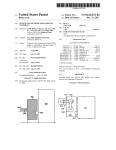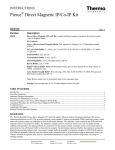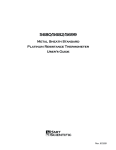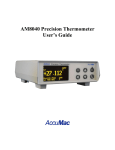Download 1 - TEquipment.NET
Transcript
5943 Gallium Melting Point Cell User’s Guide Rev. 140901 © Copyright, 2001 All Rights Reserved Hart Scientific 799 E. Utah Valley Drive American Fork, Utah 84003-9775 Telephone: (801) 763-1600 • Fax: (801) 763-1010 Internet: http://www.hartscientific.com E-mail: [email protected] Rev. 140901 Table of Contents 1 Before You Start . . . . . . . . . . . . . . . . . . . . . . . 1 1.1 1.2 1.3 Symbols Used . . . . . . . . . . . . . . . . . . . . . . . . . . 1 Safety Information . . . . . . . . . . . . . . . . . . . . . . . . 2 Customer Service Information . . . . . . . . . . . . . . . . . 2 2 Introduction . . . . . . . . . . . . . . . . . . . . . . . . . 5 3 Specifications and Environmental Conditions . . . . . . . 7 3.1 3.2 3.3 Specifications . . . . . . . . . . . . . . . . . . . . . . . . . . 7 Environmental Conditions . . . . . . . . . . . . . . . . . . . . 7 Warranty. . . . . . . . . . . . . . . . . . . . . . . . . . . . . 7 4 Construction . . . . . . . . . . . . . . . . . . . . . . . . . 9 5 Care and Handling Guidelines . . . . . . . . . . . . . . . 11 6 Operation . . . . . . . . . . . . . . . . . . . . . . . . . . 13 6.1 Freezing the Gallium . . . . . . . . . . . . . . . . . . . . . . 13 6.1.1 6.1.2 6.1.3 6.2 Melting Plateau . . . . . . . . . . . . . . . . . . . . . . . . 14 6.2.1 6.2.2 6.3 Slow Freeze Method . . . . . . . . . . . . . . . . . . . . . . . . . . . 13 Fast Freeze Method . . . . . . . . . . . . . . . . . . . . . . . . . . . 14 Automated Freeze Method . . . . . . . . . . . . . . . . . . . . . . . . 14 Realizing the Melting Point in a Bath. . . . . . . . . . . . . . . . . . . 14 Realizing the Melting Point in the 9230 Maintenance System . . . . . . 17 Correction for Pressure Difference. . . . . . . . . . . . . . . 18 i 1 Before You Start 1 1.1 Before You Start Symbols Used Table 1 lists the International Electrical Symbols. Some or all of these symbols may be used on the instrument or in this manual. Table1 International Electrical Symbols Symbol Description AC AC-DC Battery CE DC Double Insulated Electric Shock Fuse PE Ground Hot Surface Read the User’s Manual Off On Hart Scientific Manual Rev. 140901 1 1 Before You Start 1.2 Safety Information Use this instrument only as specified in this manual. Otherwise, the protection provided by the instrument may be impaired. The following definitions apply to the terms “Warning” and “Caution”. • “Warning” identifies conditions and actions that may pose hazards to the user. • “Caution” identifies conditions and actions that may damage the in- strument being used. Warnings To avoid possible electric shock or personal injury, follow these guidelines. Gallium is caustic. Consult the metal manufacturer’s MSDS (Material Safety Data Sheet). Federal law prohibits carrying this cell in the passenger section of a commercial airline. See MSDS in the back of this manual. Cautions To avoid possible damage to the instrument, follow these guidelines. Read the section entitled, Care and Handling Guidelines, before removing the gallium melting point cell from the case. Incorrect handling can damage the cell. The gallium melting point cell must be kept in a vertical position. Placing the cell in a horizontal position can damage the cell and void the warranty. 1.3 Customer Service Information Hart Scientific can be contacted by writing to: Hart Scientific, Inc. 799 E. Utah Valley Drive American Fork, UT 84003-9775 Or by calling or faxing: Telephone: (801) 763-1600 Fax: (801) 763-1010 Our World Wide Web site is: http://www.hartscientific.com E-mail: [email protected] 2 Manual Rev. 140901 5943 1 Before You Start When calling Hart Scientific Customer Service, please have the following information available: • Model Number • Serial Number Hart Scientific Manual Rev. 140901 3 1 Before You Start 4 Manual Rev. 140901 5943 2 Introduction 2 Introduction The melting point of gallium (MPGa) at 29.7646 °C is one of the defining fixed points of the International Temperature Scale of 1990 (the ITS-90). The MPGa is the phase equilibrium between the liquid phase and solid phase of pure gallium at a pressure of one standard atmospheric pressure, i.e., 101,325 Pa. The temperature of the MPGa is defined to be 29.7646 °C by the ITS-90 making it an intrinsic temperature standard. The MPGa is highly reproducible. You can get almost the same temperature wherever and whenever you realize the MPGa. The differences among the different realizations might be well within a few tenths of a millikelvin if you carefully follow the instructions given in Supplementary Information for the ITS-90, Comite Consultatif de Thermometrie (CCT), Bureau International des Poids et Mesures (BIPM) 1990. For your convenience Hart has developed a series of sealed cells and new techniques for the MPGa, which make it easier to realize the MPGa. The Model 5943 stainless steel-cased MPGa cell is a new member of the Hart MPGa sealed cells series. The Model 5943 reserves all of the benefits of the Model 5903, including extremely low uncertainty. Stainless steel is used as case material in the Model 5943 instead of the Pyrex glass used in the Model 5903. Therefore, the Model 5943 is much more durable compared with the Model 5903. The Hart sealed cells will assist you immensely in realizing the MPGa in your laboratory. The MPGa is an important fixed point for the calibration of a standard platinum resistance thermometer (SPRT). The ITS-90 specifies two subranges, i.e. from 0 °C to 29.7646 °C and from - 38.8344 °C to 29.7646 °C, in which SPRTs must be calibrated at the MPGa. Checking the stability of a temperature probe used mainly near room temperature at the MPGa is very convenient. There is widespread application for the melting point of gallium in biologic, environmental, oceanographic, geological, and energy research. Hart Scientific Manual Rev. 140901 5 2 Introduction 6 Manual Rev. 140901 5943 3 Specifications and Environmental Conditions 3 3.1 Specifications and Environmental Conditions Specifications Reproducibility 0.05 mK (0.00005°C) Cell Uncertainty (k=2) 0.08 mK – 0.15 mK (0.00008°C – 0.000015°C) Certification (k=2) 0.1 mK Purity of Gallium 99.99999% Cell Outer Diameter 38.1 mm Cell Overall Height 250.1 mm 0Entrant Well Inner Diameter 8.2 mm Immersion Depth 1 168.0 mm 1 Depth is measured from the bottom of the entrant well to the upper surface of the gallium. 3.2 Environmental Conditions Although the instrument has been designed for optimum durability and trouble-free operation, it must be handled with care. The instrument should not be operated in an excessively dusty or dirty environment. The instrument operates safely under the following conditions: • temperature range: 5-35°C (41-95°F) • ambient relative humidity: 15-50% • pressure: 75kPa – 106kPa • mains voltage within ±10% of nominal • vibrations in the calibration environment should be minimized • altitudes less than 2,000 meters 3.3 Warranty Hart Scientific, Inc. (Hart) warrants this product to be free from defects in material and workmanship under normal use and service for a period as stated in our current product catalog from the date of shipment. This warranty extends only to the original purchaser and shall not apply to any product which, in Hart’s sole opinion, has been subject to misuse, alteration, abuse or abnormal conditions of operation or handling. Hart Scientific Manual Rev. 140901 7 3 Specifications and Environmental Conditions Software is warranted to operate in accordance with its programmed instructions on appropriate Hart products. It is not warranted to be error free. Hart’s obligation under this warranty is limited to repair or replacement of a product which is returned to Hart within the warranty period and is determined, upon examination by Hart, to be defective. If Hart determines that the defect or malfunction has been caused by misuse, alteration, abuse or abnormal conditions or operation or handling, Hart will repair the product and bill the purchaser for the reasonable cost of repair. To exercise this warranty, the purchaser must forward the product after calling or writing Hart for authorization. Hart assumes NO risk for in-transit damage. For service or assistance, please contact the manufacturer. Hart Scientific, Inc. 799 East Utah Valley Drive American Fork, UT 84003-9775 Phone: (801) 763-1600 Fax: (801) 763-1010 E-mail: [email protected] THE FOREGOING WARRANTY IS PURCHASER’S SOLE AND EXCLUSIVE REMEDY AND IS IN LIEU OF ALL OTHER WARRANTIES, EXPRESS OR IMPLIED, INCLUDING BUT NOT LIMITED TO ANY IMPLIED WARRANTY OR MERCHANTABILITY, OR FITNESS FOR ANY PARTICULAR PURPOSE OR USE. HART SHALL NOT BE LIABLE FOR ANY SPECIAL, INDIRECT, INCIDENTAL, OR CONSEQUENTIAL DAMAGES OR LOSS WHETHER IN CONTRACT, TORT, OR OTHERWISE. 8 Manual Rev. 140901 5943 4 Construction 4 Construction The Model 5943 gallium melting point cell consists of a stainless steel outer shell, a stainless steel cap with an entrant well, a Teflon cell body containing the high-purity gallium and a nylon lid with nylon entrant well (Figure 1). Gallium expands on freezing by 3.1 % requiring the cell to have flexible walls. Teflon is a suitable material from this point of view, but Teflon is gas-permeable over time. Over a four-year period, completely sealed Teflon cells drift about 0.5 mK under normal use. Therefore, a stainless steel outer case is used to keep gas tight in the cell. All of the parts and material used to construct the cell were carefully cleaned to avoid any contamination to the high purity gallium. The high purity gallium was first sealed into the Teflon-nylon body in a pure argon (99.999%) atmosphere. The pressure of argon in the body was adjusted to approximate 101,325 kPa at the melting temperature. The actual value of this pressure was recorded and is reported on the Report of Test for the cell. The correction for pressure difference from the standard value of 101,325 kPa is calculated according to the actual pressure in the cell (see Section 6.3, Correction for Pressure Difference). The assembled Teflon-nylon body was then encased into the stainless steel outer shell. The stainless steel top with the entrant well was joined to the stainless steel outer case using argon-arc welding. The assembled cell was then connected to a vacuum system and pumped for more than ten hours. During the pumping period, the cell was purged with high purity argon many times. Finally, the cell was filled with 99.999% pure argon and sealed at almost the same pressure as that in the Teflon-nylon body. Hart Scientific Manual Rev. 140901 9 4 Construction Reentrant Tube Protective SST Case High Purity Metal Sample PTFE Crucible Figure 1 Construction of Gallium Melting Point Cell 10 Manual Rev. 140901 5943 5 Care and Handling Guidelines 5 Care and Handling Guidelines The Model 5943 gallium melting point cell is a delicate device. Care must be taken in handling, using, and transporting the cell. Keep the gallium in the cell in a solid state whenever possible. Store the cell in the vertical position and in a safe place. The surrounding temperature should be at least 4°C below the melting point (e.g. 25 °C or lower). Special care must be taken during transportation of the cell: • Keep the gallium in the solid state. • Store the cell in a vertical position. • Keep the surrounding temperature lower than 25 °C. If the instructions in this manual are carefully followed, the Model 5943 Gallium melting point cell will provide years of accurate use. Hart Scientific Manual Rev. 140901 11 5 Care and Handling Guidelines 12 Manual Rev. 140901 5943 6 Operation 6 6.1 Operation Freezing the Gallium The three methods for freezing the gallium cell, slow freeze, fast freeze, and automated freeze, are described in the following sections. 6.1.1 Slow Freeze Method In order to freeze all the gallium in the cell, immerse the cell in an ice bath (or a bath, with a temperature close to the ice point). First, immerse only one-fourth of the cell in the bath, thirty minutes later immerse half of the cell in the bath and another thirty minutes later immerse the three-fourths of the cell in the bath. Because of the large super cool of gallium, even though the temperature of the gallium in the cell declines to a temperature near 0 °C, all gallium might still remain in the liquid state for a period of time. Therefore, monitor the temperature in the cell by using an SPRT. When the cell is placed in an ice bath, the temperature indicated by an SPRT in the cell decreases fast at first and then decreases HEATING HEATER MODE SET DOWN UP COOLING POWER HIGH I I LOW O O EXIT High Precision Bath Figure 2 Maintenance Bath Model 7011 with Gallium Cell Insert Hart Scientific Manual Rev. 140901 13 6 Operation slowly, at last the temperature stops decreasing. After a period of time the temperature raises, a signal that the gallium starts freezing. Finally, the temperature decreases again and all of the gallium is frozen. Once frozen, the cell may be transferred to a maintenance bath such as the Hart Model 7011 (see Figure 2). 6.1.2 Fast Freeze Method The fast freeze method is based on NIST Technical Note 1265. Start with the fixed point cell at room temperature. Use liquid nitrogen to super cool two or three solid copper rods for insertion in the entrant well. The copper rods should be only slightly smaller than the inside diameter of the entrant well. For example, the Hart Model 5943 gallium cell has an entrant well with an inside diameter of 8.2 mm. The solid copper rods should have a diameter of approximately 7.0 mm. Insert the two or three super cooled copper rods into the entrant well successively to induce nucleation. As soon as the rods have been used to induce nucleation, place the cell in an ice bath for at least one hour or longer. Monitor the freeze with an SPRT. Once the freeze has been achieved, place the cell in a maintenance bath such as the Hart Model 7011 (see Figure 2). 6.1.3 Automated Freeze Method The Hart Scientific Model 9230 Maintenance System is specifically for the Model 5943 Gallium Cell. The Model 9230 has a fully automated system for maintenance of the Model 5943. Refer to the Model 9230 User’s Guide for complete information on how to use the maintenance device with the Model 5943 Gallium Cell. 6.2 Melting Plateau Realizing the melting point can be performed in a bath or in the Model 9230 Maintenance System as described below. 6.2.1 Realizing the Melting Point in a Bath A stable and long (a few days) melting plateau, during which a great amount of thermometers can be calibrated, is easy to obtain if you follow the instructions described below. Put the cell into the maintenance bath at a temperature of 0.5 °C below the melting point. Hart manufactures a Model 7011 bath with a special cell support and SPRT preheat holder for the purpose of maintaining the gallium cell (see Figure 2). Use silicone oil, 200.05 or 200.10, as the bath fluid. Light mineral oil, Hart Model 5011 oil, can be used instead of silicon oil. Use the same oil in the entrant well to provide adequate heat transfer 14 Manual Rev. 140901 5943 6 Operation Reentrant Tube Protective SST Case Solid Sample High Purity Metal Sample PTFE Crucible Liquid Sample Figure 3 Idealized Liquid/Solid Equilibrium State of a Gallium Cell Hart Scientific Manual Rev. 140901 15 6 Operation between the cell and the thermometer. The oil level in the well should be approximately the same level (52 mm below the top of the cell) as that of the gallium in the cell when the thermometer is in place in the well. With some care, distilled water can be used instead of oil as the bath fluid and heat transfer medium. Distilled water is cleaner and the viscosity of water is much lower than that of oil. The water must be kept as clean as possible. Long-term direct contact between stainless steel and dirty water causes the cell case to rust. The user should take the cell out of the bath and wipe the cell surface dry using clean tissue. When the cell is not used for a period of time, store the cell in the vertical position and in a clean place. The surrounding temperature should be below 25 °C. Before freezing the cell, remove all of the water from the entrant well using an injector or other tool. Never tilt the cell if you are not sure all of the gallium is frozen. If the temperature of the cell goes below 0 °C during freezing, the water in the entrant well freezes and might break the entrant well. The procedure for realization of a melting curve in a bath is as follows. Make sure that all gallium is frozen before starting. Maintain the bath at a temperature of 0.5 °C below the melting point for at least 30 minutes. Raise the temperature to 1 °C above the melting point at a rate of 0.2 °C per minute. Maintain the bath at this temperature for 20 minutes. Then insert an 8 watt heater into the entrant well for 4 minutes. After the 4 minutes, decrease the bath to a temperature of 0.01 °C to 0.1 °C above the melting point. Take the heater out of the entrant well and insert a preheated thermometer into the well. When the thermal equilibrium between the thermometer and pure gallium is reached (approximately 20 minutes), start the measurements. See Figure 3 for the idealized liquid/solid equilibrium state of a gallium cell at the start of the melt. A typical melting curve is shown in Figure 4. If the bath temperature is set at 0.1 °C above the melting point, the melting curve will last for more than ten days. If the 16 Manual Rev. 140901 5943 6 Operation bath temperature is set at 0.01 °C above the melting point, the melting curve will last for more than two months. A Melting Curve of Gallium in Model 9230 Cell #43002, 12/28/2000 -1/8/2001 2.843100 Bridge Reading (Rx/Rs) 2.843095 0.5 mK 2.843090 2.843085 2.843080 2.843075 2.843070 0 20 40 60 80 100 120 140 160 180 200 Time (hours) Figure 4 Typical Melting Curve of Gallium 6.2.2 Realizing the Melting Point in the 9230 Maintenance System The user should be familiar with the following details before using the Model 9230 Maintenance System. The Model 9230 is designed to automate the gallium cell melting process. This melting process is accomplished through the use of the Auto Program, a microprocessor-controlled program that determines set temperatures, scan rates, duration times, Peltier module configurations, and melt heater controls. By controlling these parameters in the proper order, a temperature profile can be maintained in the block assembly that assures a uniform melt, maintains the melt over long periods of time, properly refreezes the cell and keeps the cell ready for the next melt cycle. The only attempt in describing the melting process in this manual is to provide a simple overview. For complete details on realizing the melting point in the 9230 Maintenance System see the Model 9230 User’s Guide. In the Auto Program, the Model 9230 stabilizes at 29.27°C to allow the gallium cell to equalize. After equalization, the program initiates the melt. The block temperature is set to initiate a melt on the outer surfaces of gallium within the cell. At the appropriate time the unit beeps and the display flashes Htr on to indicate that the inner melt heater has been turned ON. This allows the user to place the inner melt heater in the entrant well of the cell to initiate the inner melt. Once the inner melt is initiated, the heater is removed from the cell. The unit automatically de-energizes the heater at the appropriate time. After the outer melt of Hart Scientific Manual Rev. 140901 17 6 Operation the cell has been appropriately initiated, the unit changes into the maintenance mode and the block temperature resets to 29.86°C. After 30 to 60 minutes stabilization time, the unit is ready for use. The duration of the melt plateau varies depending on usage, but lengths of five days or longer is achievable. 6.3 Correction for Pressure Difference The melting point of gallium, as mentioned earlier, is defined as the phase equilibrium between the liquid phase and solid phase of pure gallium at a pressure of 101,325 Pa (P0). The actual pressure, P, in a gallium cell may not be exactly the standard value. During the course of manufacturing the fixed-point cell, it is easier to seal the cell if the pressure in the cell is a little lower than room pressure. The actual pressure value in the cell just at the melting point is measured at Hart Scientific so that the correction for the difference of the pressure can be made later. Table 2 of the ITS-90 gives the data of dT/dP for all the defining fixed points. For the melting point of gallium dT/dP = -2.0 x 10 - 8 °C / Pa. Therefore, the actual equilibrium temperature t’ can be calculated using the following equation. Actual Equilibrium Temperature Equation 2.0x 10−8 (P − P0 )°C t ′ = 29.7646°C − Pa Furthermore, during the measurement at the melting point, the sensor of an SPRT is usually placed at an average height, which is 0.143 m (0.168 m – 0.025m) lower than the surface of the gallium and where the pressure is higher than that at the surface due to the static head. The correction, calculated according to the data given in Table 2 of the ITS-90, is 0.000172°C. The equilibrium temperature at an immersion depth of 0.143 m can be calculated using the following equation. Pressure Correction Equation 0.000172°C − 2.0x 10−8 (P − P0 )°C t = 29.7646°C − Pa Pressure Correction Example The pressure of argon, P, at the melting point in the gallium point cell is 91,325 Pa as given on the calibration certificate. 0.000172°C − 2.0x 10−8 ( −10000Pa )°C t = 29.7646°C − Pa t = 29.7646°C − 0.000172°C + 0.0002°C 18 Manual Rev. 140901 5943 6 Operation Thus: t = 29.764628°C Hart Scientific Manual Rev. 140901 19

































